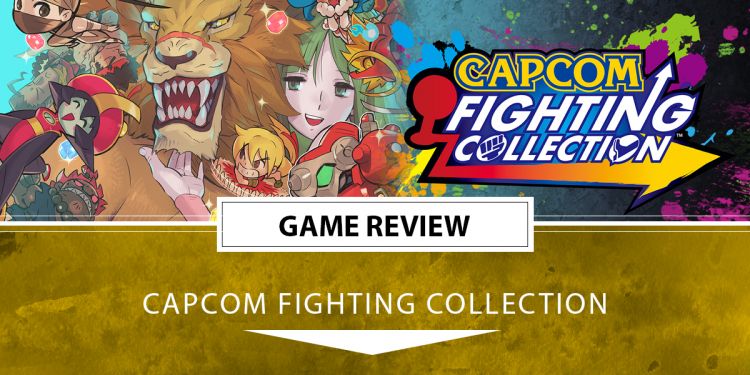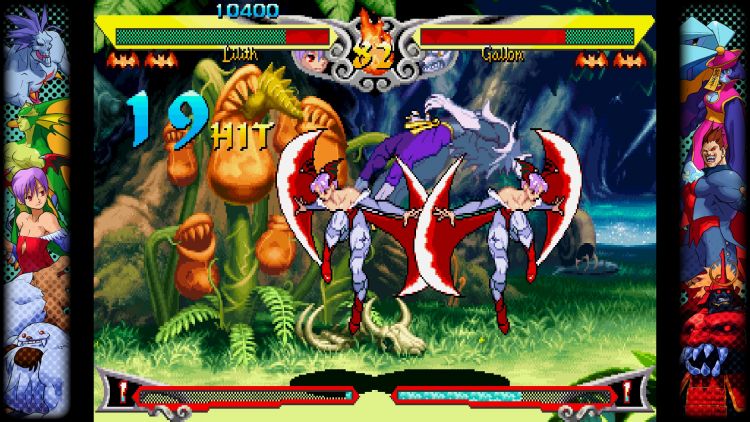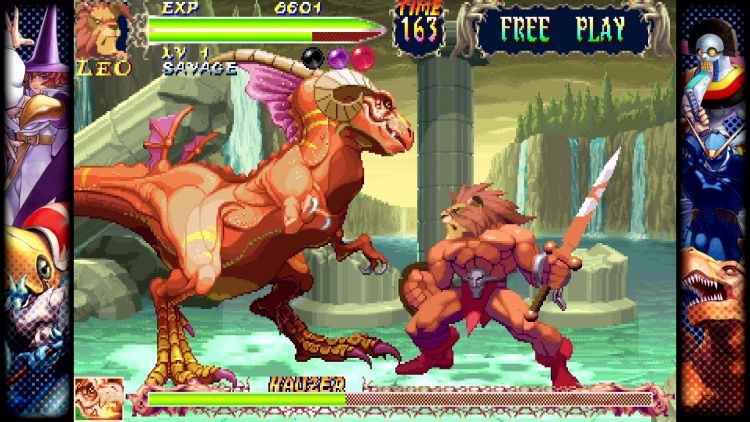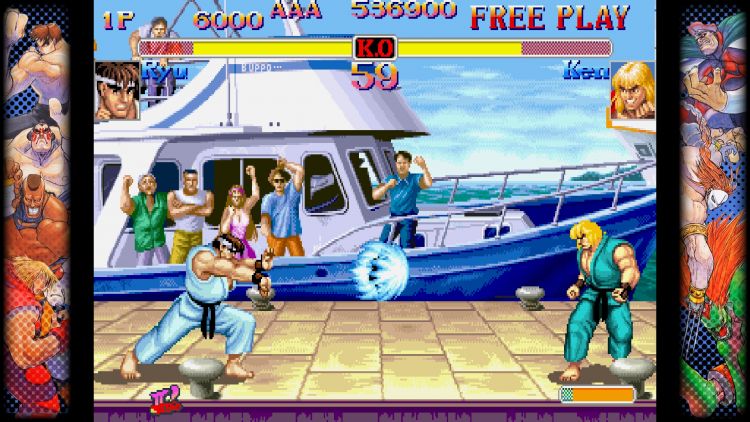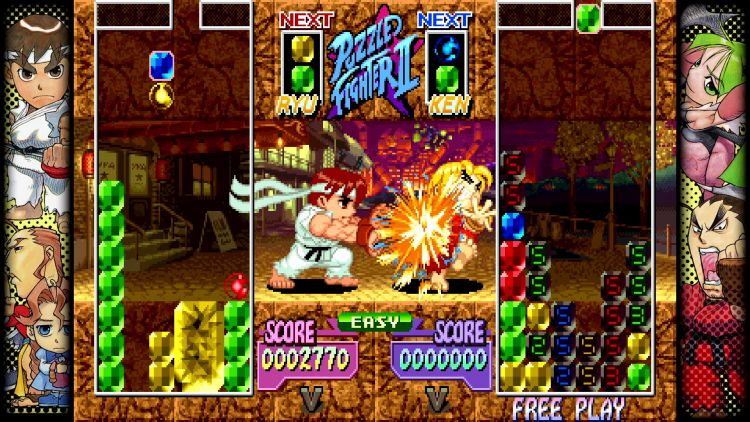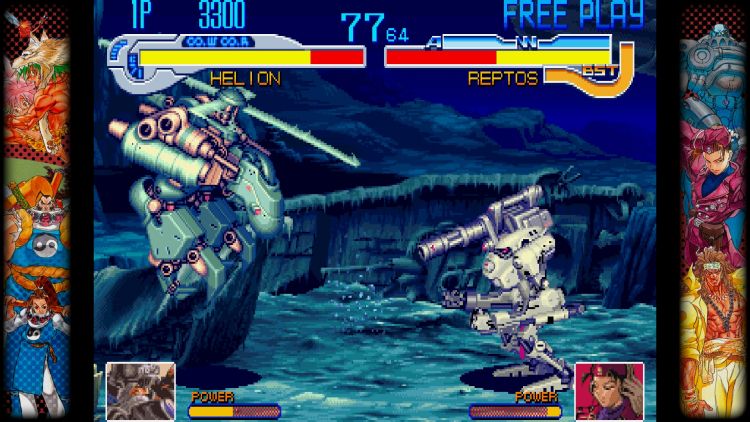Put on your backward Chicago Bulls cap, break out the sweatbands, and plug in that arcade controller as we head back to the 1990s in Capcom’s latest revisiting of its past glory in order to make a bunch of cash from those of us without a Pandora Box enabled custom Arcade machine. That’s right, Capcom Fighting Collection is the newest in the long line of the old and upcoming arcade-to-home collections in a bid to scrape some cash from your wallet. Does Capcom Fighting Collection earn its worth in quarters or has the arcade-to-home idea reached its end? Let’s find out.
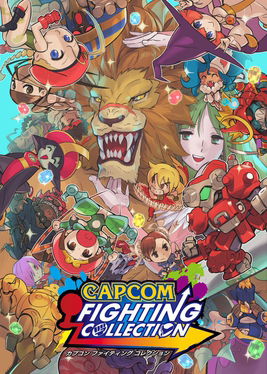 Name: Capcom Fighting Collection
Name: Capcom Fighting Collection
Platform(s): Microsoft Windows, Nintendo Switch, PlayStation 4, Xbox One
Developer: Capcom
Publisher: Capcom
Game Type: Fighting
Mode(s): Single-player, multiplayer
Release Date: June 24, 2022
Story
Capcom fighting games, like most of those in the Arcades during the 1980/1990s era, didn’t really have much of a story, with fans making up their own fiction from the snippets of information found in the games, comic books, novels, and other media they would find throughout the years. Capcom Fighting Collection doesn’t really do much to change this idea as there are no story modes and only outlines available for each game. But for the sake of giving people knowledge, here are some of the basic outlines for each of the main game series appearing in Capcom Fighting Collection.
- Darkstalkers (Darkstalkers: The Night Warriors (1994), Night Warriors: Darkstalkers’ Revenge (1995), Vampire Savior: The Lord of Vampire (1997), Vampire Hunter 2: Darkstalkers’ Revenge (1997), Vampire Savior 2: The Lord of Vampire (1997))
The Darkstalkers games take place on the planet Earth that is in the process of merging with a realm known as Makai. The reason for this merger varies depending on the continuity, but a continuing theme is that the union of realms brings the arrival of the Darkstalkers to the human world, the term being a catch-all for the various creatures of legend. The greatest of these supernatural creatures, and the greatest among those who hunt them, meet in the battle to determine who will rule the night. In the original game and the sequel, Vampire Hunter (Night Warriors: Darkstalkers’ Revenge), an alien overlord named Pyron returns to Earth after being away for many years. His quest to conquer the world using an army of robots brings the Darkstalkers out of hiding to oppose his rule over humanity and the supernatural. A second sequel, Vampire Savior (Darkstalkers 3), saw the debut of Jedah, previously one of the nobles of Makai, who decides that the only way to save the realm is to take control of it by force. Accordingly, he lures the Darkstalkers into a trap to use their collective souls to remake the realm and control both humanity and the supernatural. - Red Earth (Red Earth (1996))
Red Earth takes place on an alternate version of Earth sometime in the 14th century (the Japanese version states a post-apocalyptic 1999 however) where the world did not experience any technological revolutions or Renaissance and was still in a medieval/mythological state. A new country has risen by the evil Scion, who sends out various monsters to take over the world. Four heroes emerge to defend Earth. - Cyberbots: Full Metal Madness (Cyberbots: Full Metal Madness (1995))
In Cyberbots, the player first chooses the pilot and then the mecha (Valiant/Variant Armor or VA for short) they’ll use to fight. The mechas determine the gameplay of the game, but the pilot is what determines the storyline the player will see. Near the end of the 21st century, Earth begins to become overpopulated leading to many people living in man-made space colonies. The primary army of Earth, “Earth Force”, has been conducting experiments and their work, along with the actions of the playable characters will determine the future of Earth. - Street Fighter (Super Puzzle Fighter II Turbo (1996), Super Gem Fighter Mini Mix (1997), Hyper Street Fighter II: The Anniversary Edition (2003))
The leader of the Shadaloo organization, M. Bison, in his global domination plan sets up a world-fighting tournament, to select the best fighters to work in his Shadaloo organization through brainwashing. M. Bison’s plans are foiled by Akuma (who was not a competitor in the tournament) who catches him off guard and performs the Shun Goku Satsu on him, killing the Shadaloo boss in an instant. Akuma then takes M. Bison’s place in the tournament to fight the finalist, who some sources hint is Ryu. Akuma mocks M. Bison for being the slave of his own power, not knowing that he is actually in absolute control of his Psycho Power.
Graphics
If you’re heading into Capcom Fighting Collection thinking that you are going to get some sort of amazing 4K, 60fps upgrade to these original arcade classics, then you are going to be in for a rude awakening. Capcom Fighting Collection is a 1:1 recreation of the arcade games through emulation.
Nothing has been upgraded or changed here. What you get are the same 4:3 format games that we got back in the 1990s. Sure, there are some filters available (Which I recommend using, as the filterless graphic options A, B, & C are horrible. You’ll want those TV scanlines… Trust me) and you can stretch the games into a widescreen version, but honestly, those things are almost a crime to use since you need to play this in the original formatting, even if it means adding those art images to the size so the screen fits our modern 16:9 TV and monitors.
Speaking of screens, I wouldn’t play Capcom Fighting Collection on anything bigger than a 42-inch TV or monitor with a 29 to 32-inch is the perfect size since the screens these games were designed for were around this size at the time and going to something like 50, 65, 75+ inch screens is going to stretch the games too much and the sprites are not going to react favorably giving a horrible time.
Gameplay
A lot of the games in Capcom Fighting Collection were designed with the CPS-II and CPS-III systems that Capcom had back in the day, with most of them having the same overall gameplay experience. Using 4-6 buttons in the Heavy, Medium, and Light punch/kick versions, you’ll be picking a single fighter and battling your way through a roster of other fighters before ending up at the overpowered boss/bosses in order to win and become the ultimate fighter, hero of the world, savior of the world, or whatever basic gaming story ties into the game that you are playing. As you go through most of the games, you’ll have some other techniques that come into play, such as super moves: A more powerful version of a special move that does a lot more damage.
The only game that actually plays differently in Capcom Fighting Collection is Super Puzzle Fighter II Turbo, which is a “match 3 or more” game where you put the colors together and take them off the board, adding them to your opponent’s side in a fighter to see who can top the playing field out first and lose. Other than that, you have the standard fighter where you have 2 out of 3 rounds to win in order to advance to the next fight. If you’ve played any Capcom fighting game in the last 35 years, then you’ll know how to play any of these games in the Capcom Fighting Collection.
However, if you do not know how to play any of these games, then most of them come with a training mode where you can smash the shit out of a non-functioning CPU opponent till you have enough confidence to take on the CPU in the offline mode, or if you really have some brass balls, head into the online mode where you can play in the classic arcade-style of anyone coming in at any time to challenge you to a fight.
Thankfully, Capcom Fighting Collection has the great functioning “Rollback Netcode” online functionality, which makes the fights work really smooth… Just like it has in every other Capcom release in the last few years.
Replayability
Capcom Fighting Collection has a lot to offer, with 10 games available to play, and with 3 of those being available for the first time ever outside of an Arcade or Mame Emulator, you would think there are years worth of playing to be done… However, once you beat each game, outside of beating those games again with every other character, there isn’t much point left to these games.
As someone who played a lot of these back in the day, it is nice to have them available to me in my home at any time. Yet, when I go to boot them up and keep gaming for the review, I find that they don’t have the same lasting appeal as they once did. Then there is the other problem, which I’ll mention when I wrap things up which will really make you wonder if you would want to buy these games in this Capcom Fighting Collection package.
Extras
Much like other Capcom collections, you do get some interesting extras in Capcom Fighting Collection. You get a bunch of achievements for those of you who think you still need these terrible “pat on the back” style things in your video games. A lot of these achievements are for playing in-game, starting the game once, finishing the game, or doing something with one of the characters that are hard to do, plus, there are some online-only achievements to force you to head online to get that shiny digital trophy.
Outside of this addition, you have a Museum feature where you can view images from each game which ranges from artwork tributes to the game to behind-the-scenes production art, and official media that was released to arcade owners such as promotional material. Finally, and the best part of the extras… MUSIC!! Yep, Capcom Fighting Collection has a whole section dedicated to the bumpin tracks of video games in the 1990s. Every game has a selection of tracks from their stages here which would be awesome for any video game music lover; this section alone is well worth a listen even when you are not playing.
Closing
Capcom Fighting Collection is a good collection, and having Red Earth, along with the other 2 Darkstalkers games available for the first time since their original 1990s arcade release is cool and all, but then I went online and check the release list for the upcoming Capcom Arcade Stadium 2 release… and my heart sank. Capcom Arcade Stadium 2 is going to have 6 out of the 10 games represented in Capcom Fighting Collection in that release (Also, Cyberbots was represented in Capcom Arcade Stadium already).
This makes me wonder why they didn’t just wait a few months and add these as a Capcom Fighting Collection pack in Capcom Arcade Stadium 2 instead. Knowing this, I wonder if Capcom Fighting Collection was just a cheap cash grab by Capcom and then double dipping soon with their next arcade collection release, or the actual decent attempt at appealing to the hardcore fighting game fans who grew up with these titles back in the glory days of the arcade.
Review Disclosure Statement: Capcom Fighting Collection was provided to us by Capcom for review purposes. For more information on how we conduct and handle reviews here, please visit our Review Guideline/Scoring Policy for more info. Thank you
Summary
Capcom Fighting Collection brings us a good batch of arcade-perfect ports that are themed into a package that is great if you just want those specific titles to play at all times, but with 6 of them appearing in Capcom Arcade Stadium 2, and one already in Capcom Arcade Stadium, Capcom Fighting Collection comes off as a quick cash grab that really should have been pushed out as another DLC pack for either Capcom Arcade Stadium release. Your mileage is going to vary on how desperately you want 3 games that haven’t seen a release since the 1990s… and by the looks of it, will never see a release again.
Pros
- Perfect Arcade conversions
- Red Earth, Vampire Hunter 2: Darkstalkers’ Revenge, and Vampire Savior 2: The Lord of Vampire available for the first time in decades
- The soundtrack is full of bops
Cons
- Not many extras outside of images, music, and artwork
- Finding out 7 out of 10 games have appeared or will appear in Capcom Arcade Stadium releases
- No difficulty toggles


